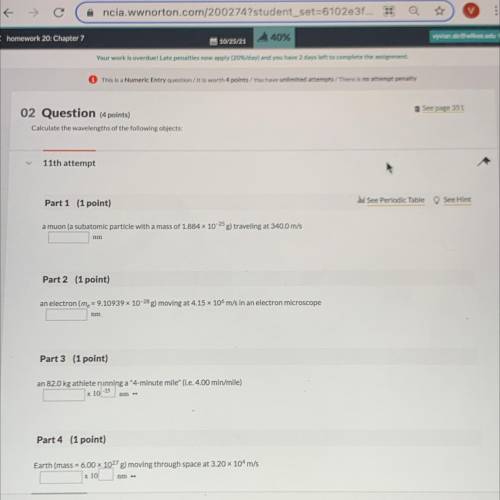Calculate the wavelengths of the following objects:
Part 1 (1 point)
See Periodic Table See...

Chemistry, 25.10.2021 23:20, babyboogrocks5695
Calculate the wavelengths of the following objects:
Part 1 (1 point)
See Periodic Table See Hint
a muon (a subatomic particle with a mass of 1.884 x 10-25 g) traveling at 340.0 m/s
nm
Part 2 (1 point)
an electron (me = 9.10939 x 10-28 g) moving at 4.15 x 106 m/s in an electron microscope
nm
Part 3 (1 point)
an 82.0 kg athlete running a "4-minute mile" (i. e. 4.00 min/mile)
x 10-25
nm
Part 4 (1 point)
Earth (mass = 6.00 x 10278) moving through space at 3.20 x 10m/s
x 10
nm


Answers: 2
Other questions on the subject: Chemistry

Chemistry, 23.06.2019 08:00, Robinlynn228
Pl what kind of reaction is this? nahco3 + h2o → co2 + naoh + h2o -composition -decomposition -single replacement -double replacement im leaning more toward single replacement. if im wrong can you explain whyy?
Answers: 1


Chemistry, 23.06.2019 13:30, bossboybaker
What happens to acetone molecules when you add heat to a beaker of liquid acetone?
Answers: 1
Do you know the correct answer?
Questions in other subjects:






Mathematics, 16.04.2021 01:00

Mathematics, 16.04.2021 01:00

Mathematics, 16.04.2021 01:00

Health, 16.04.2021 01:00

Mathematics, 16.04.2021 01:00






